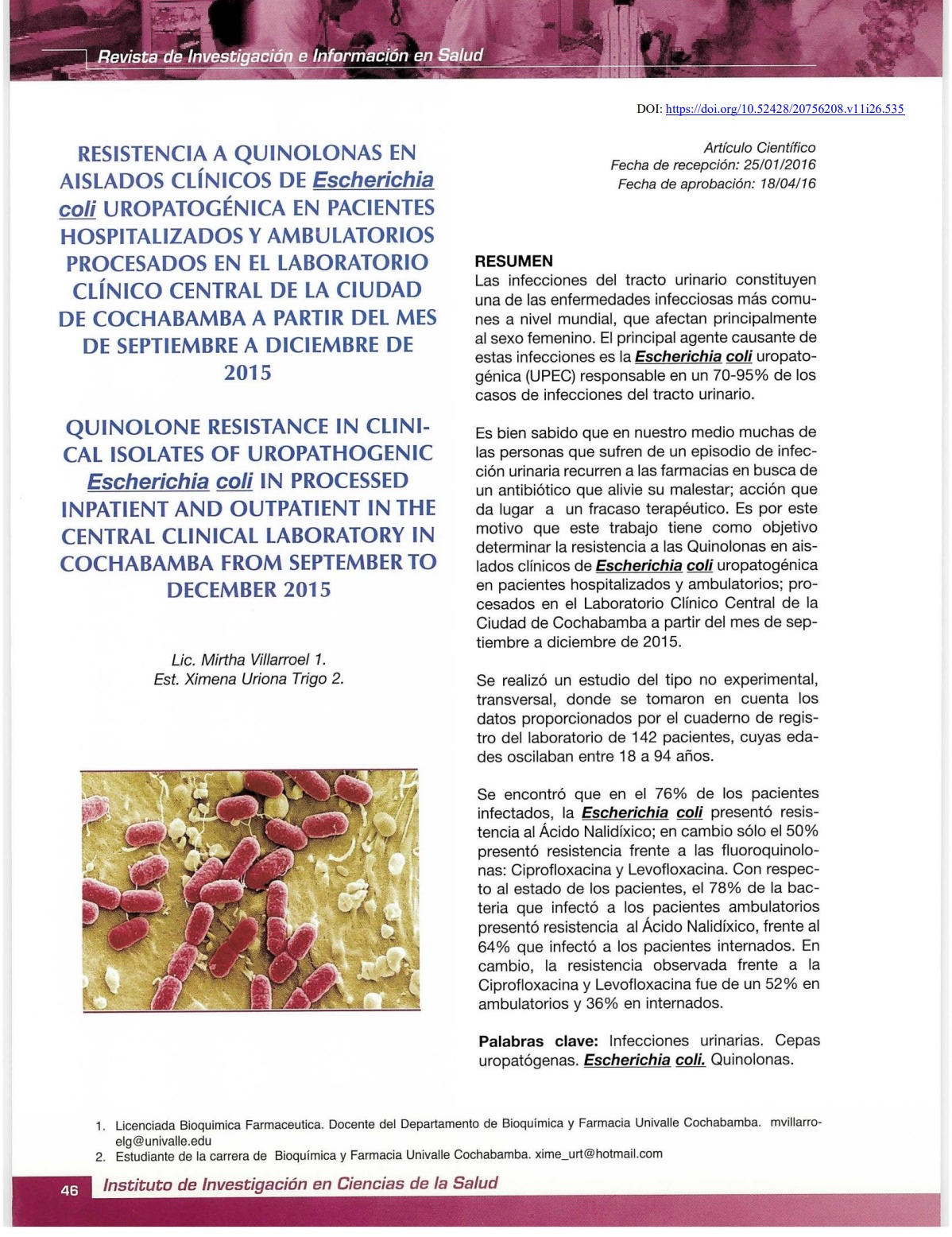Quinolone Resistance in Clinical Isolates of Uropathogenic Escherichia Coli in Processed Inpatient and Outpatient in the Central Clinical Laboratory in Cochabamba From September to December 2015
DOI:
https://doi.org/10.52428/20756208.v11i26.535Keywords:
Urinary infections, pathogenic strains, Escherichia coli, QuinolonesAbstract
Urinary tract infections are one of the most common infectious diseases worldwide, affecting mainly females. Women under 10 years and those from 18 to 40 years old (sexually active) are most often acquire these infections uropathogenic Escherichia co!i (UPEC), being this the responsible agent for the infection in 70-95% of all uncomplicated cases and 30% in nosocomial infections cases. lt is well known that in our country many people who suffer from an episode of urinary tract infection go to pharmacies in search of an antibiotic to relieve their discomfort; action that leads to a therapeutic failure. That is why this work is to determine the resistance to quinolones in clinical isolates of uropathogenic Escherichia coli in inpatient and outpatient processed at the Central Clinical Laboratory of the City of Cochabamba from September to December 2015 patients. A non-experimental, cross type study was performed, where the data was provided by the laboratory logbook of 142 patients, whose ages ranged from 18 to 94 years. lt was found that 76% of patients had resistance Nalidixic Acid; however only 50% showed resistance to fluoroquinolones: ciprofloxacin and levofloxacin. Regarding the state of patients, 78% of outpatient presented nalidixic acid resistance compared with 64% of the internees. Instead, the observed resistance against ciprofloxacin and levofloxacin was 52% in outpatient and 36% in inpatient.
Downloads
References
1. GUAJARDO-LARA C, GONZALES-MARTINEZ P , AVALA- GAYTÁN J, Resistencia antimicrobiana en la infección urinaria por Escherichia coli adquirida en la comunidad. ¿Cuál antibiótico voy a usar? 2008. En línea: http://www.scielo.org.mx/scielo.php?pid=S003636342009000200012&script=sci_arttext&tlng=en Consultado el 10 de enero del 2016 a 20:00 hrs
2. SEIJA V, FRANTCHEZ V, PINTOS M , BATAGLINO M, TORALES M, DÍAZ A Y DEFRECHOU C. Etiología de la infección urinaria de adquisición comunitaria y perfil de susceptibilidad de Escherichia coli a los principales agentes anti microbianos. 2009. En línea: http://www.scielo.edu.uy/scielo.php?pid=S168803902010000100003&script=sci_arttext Consultado el 12 de enero del 2016 a 23:00 hrs
3. MOLINA, José; MANJARREZ, Ángel. Infecciones de vías urinarias. Escherichia coli. En línea: http://www.facmed.unam.mx/deptos/microbiologia/bacteriologia/enfermedades-vias urinarias.html. (Consulta: 1 6 de Noviembre de 2015 a 19:00 hrs.).
4. MURRAY P, ROSENTHAL K, PFALLER M. Microbiología Médica. 7° Edición. Barcelona: Elsevier. 2014
5. SORDELLI D, CEROUETTI C, CATALANO M. Microbiología Médica. 1º Edición. Buenos Aires: La Librería de la Ciencia. 2004
6. JÁUREGUI L, Anti microbianos: Uso terapéutico en lnfectología Clínica. 1 º Edición. La Paz: Plural Editores. 2002.

Downloads
Published
How to Cite
Issue
Section
License
Copyright (c) 2016 Mirtha Villarroel y Ximena Uriona Trigo

This work is licensed under a Creative Commons Attribution 4.0 International License.
Authors who publish with this journal agree to the following terms:
- Authors retain copyright and grant the journal right of first publication with the work simultaneously licensed under a Creative Commons Attribution License 4.0 that allows others to share the work with an acknowledgement of the work's authorship and initial publication in this journal.
- Authors are able to enter into separate, additional contractual arrangements for the non-exclusive distribution of the journal's published version of the work (e.g., post it to an institutional repository or publish it in a book), with an acknowledgement of its initial publication in this journal.
- Authors are permitted and encouraged to post their work online (e.g., in institutional repositories or on their website) prior to and during the submission process, as it can lead to productive exchanges, as well as earlier and greater citation of published work.






















